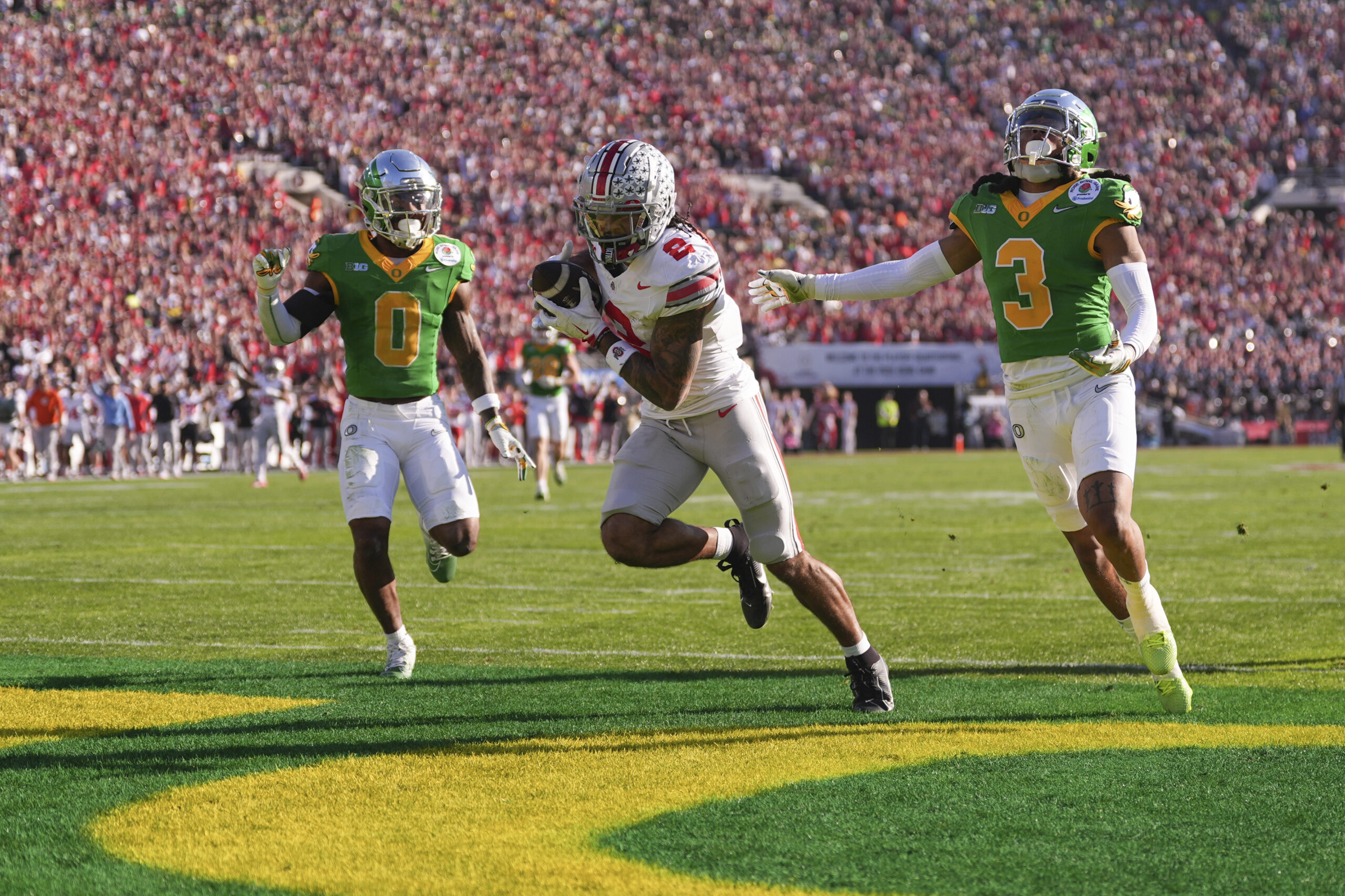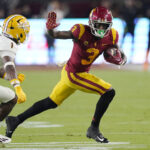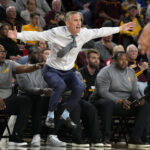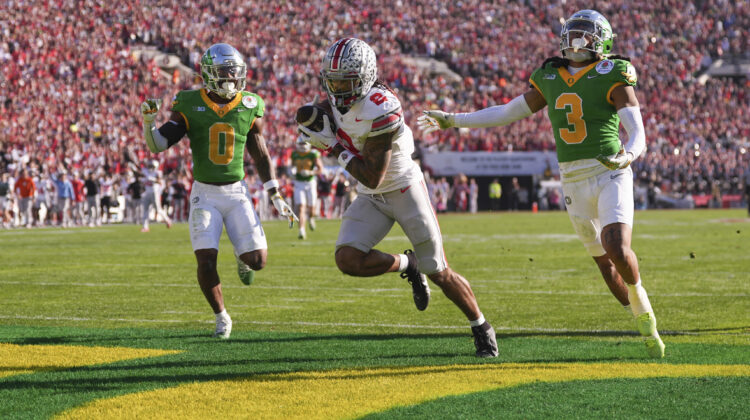Two weeks later, the Rose Bowl result is even more baffling than it felt in real time.
Ohio State obliterated Oregon — the nation’s No. 1 team, the lone unbeaten, the betting favorite to win the College Football Playoff.
With 8:47 remaining in the second quarter, the Buckeyes had run 25 plays and scored 31 points.
The Ducks had run 23 plays and scored zero points.
The game was over.
 “Oregon walked into a Mike Tyson fight,” Chris Petersen, the Fox Sports analyst and former Boise State and Washington coach, told the Hotline earlier this week. “It was one of those, ‘What just happened?’ things.”
“Oregon walked into a Mike Tyson fight,” Chris Petersen, the Fox Sports analyst and former Boise State and Washington coach, told the Hotline earlier this week. “It was one of those, ‘What just happened?’ things.”
But just nine days after they looked untouchable against Oregon, the Buckeyes struggled to put away Texas, which needed two overtimes to beat Arizona State in the quarterfinals.
What happened in Pasadena on Jan. 1? Why were the Ducks so badly outclassed by an opponent they defeated in the middle of the season, a team that lost to Michigan and struggled against Texas?
Put another way: Did the Rose Bowl expose a weakness hidden by Oregon’s regular-season success, a shortcoming that could only be exposed by a blue-blood opponent on the sport’s biggest stage?
“Remember, that game at Autzen was very close,” former Ducks coach Mike Bellotti said, referring to Oregon’s 32-31 victory over the Buckeyes in October.
“When they played the second time, Ohio State created great matchups. The avalanche came and, my gosh, it was the perfect storm. (The Ducks) didn’t stop playing, they were just overwhelmed.”
The performance echoed a postseason blowout from years earlier, but not the one you might think — not the Ducks’ 42-20 loss to Ohio State in the 2014 national championship game. That was a one-point affair until the final seconds of the third quarter, when the Buckeyes took control. It was nothing like what we witnessed two weeks ago.
The closest historical parallel is the 2006 Las Vegas Bowl, when the Ducks were run off the field by Brigham Young. They trailed by 17 points at halftime and by 31 early in the fourth quarter of what became a 38-8 loss.
“Sometimes, you get overwhelmed early,” said Bellotti, who coached Oregon from 1995-2008. “The first play of the Las Vegas Bowl, we had a flea-flicker called. The receiver was open, but the quarterback didn’t see him and took a sack. The first drive can be indicative of how you match up.”
From that game, everything changed.
Bellotti hired Chip Kelly and committed to the no-huddle offense that revolutionized the sport and transformed Oregon’s program into a power.
“We had already gone to the shotgun and zone-read in 2005. But (with Kelly), we went to the no-huddle exclusive,” he said. “The game stuck in my craw. I felt like we needed a change.”
Should Ducks coach Dan Lanning reconsider his scheme or strategy to better position his program for the biggest matchups, when Oregon doesn’t possess a decisive edge in personnel?
To date, Lanning is 2-4 in the most meaningful games, with three narrow losses to Washington, wins over Ohio State and Penn State (in the Big Ten championship) and the wipeout in the Rose Bowl.
We posed the question to Bellotti, Petersen and Rick Neuheisel, the former Washington, UCLA and Colorado coach who serves as a lead studio analyst for CBS Sports.
The consensus: The shortcomings in Pasadena were largely specific to that moment and that matchup.
— The time off.
By virtue of winning the Big Ten, the Ducks earned a bye in the opening round of the CFP, resulting in a three-and-a-half-week break between the conference championship and the Rose Bowl.
Ohio State had three weeks off between its loss to Michigan at the end of the regular season and the CFP opening-round matchup against Tennessee, then a mere 10-day break before facing the Ducks in the quarterfinals.
In the Rose Bowl, the Buckeyes were faster, sharper and crisper than Oregon from the first minute to the last.
“Anytime you don’t play for three weeks, you’re going to lose your edge,” Bellotti said. “That’s just a fact.”
— Too good for their own good?
The Ducks’ dominant regular season (13-0) wasn’t without close calls. They were pushed to the brink by Boise State early, Ohio State at the midway point and Wisconsin late, then struggled to put away Penn State in the Big Ten championship.
But they never faced real adversity. They were never forced to dig deep.
“Oregon had a spectacular season,” Petersen said. “Sometimes, when it’s so special, it can hurt you. Look at what Ohio State went through with that debacle against Michigan. They used that to make them better.
“It’s so hard to be undefeated. But sometimes, that edge can be dulled. Oregon got hit so hard and so fast by a team with a chip on its shoulder.”
— Oregon’s defense: outmanned and overwhelmed.
Credit Ohio State coach Ryan Day and Kelly, the offensive coordinator, for recognizing their mistake. The Buckeyes tried to play bully-ball against Michigan, and it cost them dearly in the 13-10 stunner.
But against Tennessee in the opening round and again in the Rose Bowl, the Buckeyes made early and ample use of their tremendous receivers, then turned to their running game once the defense loosened up.
“I think (Lanning) made the comment that he didn’t feel the coaches came up with the right plan” in the Rose Bowl, Bellotti said. “It didn’t account for certain things.”
By all appearances, it didn’t account for Ohio State receiver Jeremiah Smith, who had seven catches for 187 yards and two touchdowns.
One week later, Smith had one catch for three yards against Texas.
— Oregon’s offense: “no answers”
Ohio State defensive coordinator Jim Knowles is one of the best in the business and has NFL talent on every level, including all-everything safety Caleb Downs.
The Ducks were no match for the Knowles-Downs combination.
“I thought it was a brilliant plan by Knowles,” Neuheisel said. “They played a nickel front with Downs as the Monster, meaning he played between the inside linebackers and about three yards behind them. You can run myriad coverages from there.
“You can wait for the crossers. You can play Tampa 2 to cover the seams. It was an ingenious way to play because Oregon ran so many crossing patterns against Penn State.
“And Ohio State’s front gave (Oregon quarterback) Dillon Gabriel all sorts of fits.”
The Buckeyes’ elite defensive line generated constant pressure without relying on stunts and blitzes, and their linemen often stopped a few feet short of Gabriel in order to contain him in the pocket. They then jumped to deflect his throws.
“They had no answers in the first half,” Neuheisel said. “They got schemed up by Knowles given that he had a second look at what they do.”
So if major changes aren’t necessary, what tweaks are required to better prepare the Ducks for marquee matchups in the future?
Neuheisel believes they must recruit bigger defensive backs. Smith, the Ohio State star, is 6-foot-3 — and only a freshman. He’s the same height as former Washington wideout Rome Odunze, who had 16 catches for 230 yards in two games against the Ducks in 2023.
Bigger defensive backs would help with run support, as well.
The Ducks gave up 78 points and 1,023 yards in their final two games of the season, against Penn State and Ohio State. Almost half (478) came on the ground.
Another question as the Ducks look ahead to the fall: Is sophomore quarterback Dante Moore the answer?
A former blue-chip recruit, Moore started five games for UCLA in 2023 as a freshman, then transferred to Oregon and played sparingly.
“Is Moore good enough after throwing seven passes this season?” Neuheisel said. “Lanning has only coached fifth- and sixth-year seniors at Oregon (Bo Nix and Gabriel). He’s never had to raise one. This would be a new deal with an inexperienced quarterback playing with all these toys.
“Is (Moore) a player ready to play for the national championship?”
There is no equivalent to Nix or Gabriel currently available to Oregon in the transfer portal.
Georgia’s Carson Beck has committed to Miami.
Washington State’s John Mateer is headed to Oklahoma.
And Texas’ Quinn Ewers is off to the NFL.
“A lot will depend on the quarterback,” Bellotti said. “But I think with the framework Dan’s setting up, they will only get better over time. He doesn’t need any big changes.”
*** Send suggestions, comments and tips (confidentiality guaranteed) to wilnerhotline@bayareanewsgroup.com or call 408-920-5716
*** Follow me on the social media platform X: @WilnerHotline
Related posts:

Southern California wide receiver Jordan Addison, (AP Photo/Mark J. Terrill)
Pac-12 sends 31 players to the NFL scouting combine: What that means and what to watch
Arizona State coach Bobby Hurley (AP Photo/Rick Scuteri)
Hurley contract extension the right move… Pac-12 athletic department power ratings: Which schools are making the most of the dollars spent?
Pac-12 athletic department power ratings: Which schools are making the most of the dollars spent?

(AP Photo/Ralph Freso, File)
Mailbag: Pac-12 presidential tumult (and what it means), imagining the ADs in charge, current TV dollars, the survival line and more

